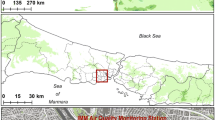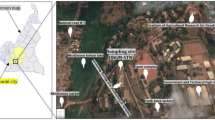Abstract
Information on the relationship between black carbon (BC) and particle number levels in urban areas is limited. Therefore, investigating the relationship between BC and particle number levels in different particle size ranges at an urban area is worthwhile. This study used an aethalometer and scanning mobility particle sizer to measure the levels of BC and particle number simultaneously at an urban roadside in Taipei City. Measurement results show that hourly BC levels are 0.62–8.80 μg m−3 (mean = 3.50 μg m−3) and hourly particle number levels are 4.21 × 103–4.64 × 104 particles cm−3 (mean = 2.00 × 104 particles cm−3) in Taipei urban area. The BC and particle number levels peak during morning (7:00–9:00) and evening (16:00–18:00) rush hours on weekdays. Low BC and particle number levels exist in the early morning hours. Time variations in BC levels are the same as those of particle number levels in this study, clearly indicating that BC and particles are likely released from the same emission source. Additionally, BC levels in the urban area are more strongly associated with ultrafine particle levels than with total particle number levels, particularly in the size range of 56–180 nm. According to measurement results, most BC in aerosols in urban areas can be in the ultrafine size range.





Similar content being viewed by others
References
Beckerman B, Jerrett M, Brook JR, Verma DK, Arain MA, Finkelstein MM (2008) Correlation of nitrogen dioxide with other traffic pollutants near a major expressway. Atmos Environ 42:275–290
Boogaard H, Kos GPA, Weijers EP, Janssen NAH, Fischer PH, Zee SC, Hartog JJ, Hoek G (2011) Contrast in air pollution components between major streets and background locations: particulate matter mass, black carbon, elemental composition, nitrogen oxide and ultrafine particle number. Atmos Environ 45:650–658
Charron A, Harrison RM (2003) Primary particle formation from vehicle emissions during exhaust dilution in the roadside atmosphere. Atmos Environ 37:4109–4119
Fruin S, Westerdahl D, Sax T, Sioutas C, Fine PM (2008) Measurements and predictors of on-road ultrafine particles concentrations and associated pollutants in Los Angeles. Atmos Environ 42:207–219
Hagler GSW, Baldauf RW, Thoma ED, Long TR, Snow RF, Kinsey JS, Oudejans L, Gullett BK (2009) Ultrafine particles near a major roadway in Raleigh, North Carolina: downwind attenuation and correlation with traffic-related pollutants. Atmos Environ 43:1229–1234
Hussein T, Puustinen A, Aalto PP, Mäkelä JM, Hämeri K, Kulmala M (2004) Urban aerosol number size distributions. Atmos Chem Phys 4:391–411
Hussein T, Hämeri K, Aalto PP, Paatero P, Kulmala M (2005) Modal structure and spatial–temporal variations of urban and suburban aerosols in Helsinki—Finland. Atmos Environ 39:1655–1668
Hyvärinen AP, Kolmonen P, Kerminen VM, Virkkula A, Komppula M, Hatakka J, Burkhart J, Stohl A, Aalto P, Kulmala M, Lehtinen KEJ, Viisanen Y, Lihavainen H (2011) Aerosol black carbon at five background measurement sites over Finland, a gateway to the Arctic. Atmos Environ 45:4042–4050
Invernizzi G, Ruprecht A, Mazza R, Marco CD, Močnik G, Sioutas C, Westerdahl D (2011) Measurement of black carbon concentration as an indicator of air quality benefits of traffic restriction policies within the ecopass zone in Milan, Italy. Atmos Environ 45:3522–3527
Jacobson MZ (2010) Short-term effects of controlling fossil-fuel soot, biofuel soot and gases, and methane on climate, Arctic ice, and air pollution health. J Geophys Res 115:D114209. doi:10.1029/2009JD013795
Jansen KL, Larson TV, Koening JQ, Mar TF, Fields C, Stewart J, Lippmann M (2005) Associations between health effects and particulate matter and black carbon in subjects with respiratory disease. Environ Health Perspect 113:1741–1746
Matson U (2005) Indoor and outdoor concentrations of ultrafine particles in some Scandinavian rural and urban areas. Sci Total Environ 343:169–176
Morawska L, Ristovski Z, Jayaratne ER, Keogh DU, Ling X (2008) Ambient nano and ultrafine particles from motor vehicle emissions: characteristics, ambient processing and implications on human exposure. Atmos Environ 42:8113–8138
Park K, Chow JC, Watson JG, Trimble DL, Doraiswamy P, Arnott WP, Stroud KR, Bowers K, Bode R, Petzold A, Hansen ADA (2006) Comparison of continuous and filter-based carbon measurements at the Fresno Supersite. J Air Waste Manag Assoc 56:474–491
Pérez N, Pey J, Cusack M, Reche C, Querol X, Alastuey A, Viana M (2010) Variability of particle number, black carbon, and PM10, PM2.5, and PM1 levels and speciation: influence of road traffic emissions on urban air quality. Aerosol Sci Technol 44:487–499
Power MC, Weisskopf MG, Alexeeff SE, Coull BA, Spiro A III, Schwartz J (2011) Traffic-related air pollution and cognitive function in a cohort of older men. Environ Health Perspect 119:682–687
Ramachandran S, Kedia S (2010) Black carbon aerosols over an urban region: radiative forcing and climate impact. J Geophys Res 115:D10202. doi:10.1029/2009JD013560
Ramanathan V, Carmichael G (2008) Global and regional climate changes due to black carbon. Nat Geosci 1:221–227
Ramanathan V, Feng Y (2009) Air pollution, greenhouse gases and climate change: global and regional perspectives. Atmos Environ 43:37–50
Reche C, Querol X, Alastuey A, Viana M, Pey J, Moreno T, Rodríguez S, González Y, Fernández-Camacho R, Sánchez de la Campa AM, De la Rosa J, Dall’Osto M, Prévôt ASH, Hueglin C, Harrison RM, Quincey P (2011) New considerations for PM, black carbon and particle number concentration for air quality monitoring across different European cities. Atmos Chem Phys 11:6207–6227
Rich DQ, Schwartz J, Mittleman MA, Link M, Luttmann-Gibson H, Catalano PJ, Speizer FE, Dockery DW (2005) Association of sort-term ambient air pollution concentrations and ventricular arrhythmias. Am J Epidemiol 161:1123–1132
Rodríguez S, Dingenen RV, Putaud JP, Dell’Acqua A, Pey J, Querol X, Alastuey A, Chenery S, Ho KF, Harrison R, Tardivo R, Scarnato B, Gemelli V (2007) A study on the relationship between mass concentrations, chemistry and number size distribution of urban fine aerosols in Milan, Barcelona and London. Atmos Chem Phys 7:2217–2232
Rodríguez S, Cuevas E, González Y, Ramos R, Romero PM, Pérez N, Querol X, Alastuey A (2008) Influence of sea breeze circulation and road traffic emissions on the relationship between particle number, black carbon, PM1, PM2.5 and PM2.5-10 concentrations in a coastal city. Atmos Environ 42:6523–6534
Schulz M, Textor C, Kinne S, Balkanski Y, Bauer S, Berntsen T, Berglen T, Boucher O, Dentener F, Guibert S, Isaksen ISA, Iversen T, Koch D, Kirkevåg A, Liu X, Montanaro V, Myhre G, Penner JE, Pitari G, Reddy S, Seland Ø, Stier P, Takemura T (2006) Radiative forcing by aerosols as derived from the AeroCom present-day and pre-industrial simulations. Atmos Chem Phys 6:5225–5246
Shi JP, Evans DE, Khan AA, Harrison RH (2001) Sources and concentration of nanoparticles (<10nm diameter) in the urban atmosphere. Atmos Environ 35:1193–1202
Snyder DC, Rutter AP, Worley C, Olson M, Plourde A, Bader RC, Dallmann T, Schauer JJ (2010) Spatial variability of carbonaceous aerosols and associated source tracers in two cities in the Midwestern United States. Atmos Environ 44:1597–1608
Suglia SF, Gryparis A, Schwartz J, Wright RJ (2008a) Association between traffic-related black carbon exposure and lung function among urban women. Environ Health Perspect 116:1333–1337
Suglia SF, Gryparis A, Wright RO, Schwartz J, Wright RJ (2008b) Association of black carbon with cognition among children in a prospective birth cohort study. Am J Epidemiol 167:280–286
Viidanoja J, Sillanpää M, Laakia J, Kerminen VM, Hillamo R, Aarnio P, Koskentalo T (2002) Organic and black carbon in PM2.5 and PM10: 1year of data from an urban site in Helsinki, Finland. Atmos Environ 36:3183–3193
Westerdahl D, Fruin S, Sax T, Fine PM, Sioutas C (2005) Mobile platform measurements of ultrafine particles and associated pollutant concentrations on freeways and residential streets in Los Angeles. Atmos Environ 39:3597–3610
Acknowledgments
The authors would like to thank the National Science Council of the Republic of China, Taiwan, for financially supporting this research under Contract No. NSC100- 2221-E-131-001.
Author information
Authors and Affiliations
Corresponding author
Additional information
Responsible editor: Philippe Garrigues
Rights and permissions
About this article
Cite this article
Cheng, YH., Shiu, BT., Lin, MH. et al. Levels of black carbon and their relationship with particle number levels—observation at an urban roadside in Taipei City. Environ Sci Pollut Res 20, 1537–1545 (2013). https://doi.org/10.1007/s11356-012-1081-z
Received:
Accepted:
Published:
Issue Date:
DOI: https://doi.org/10.1007/s11356-012-1081-z




